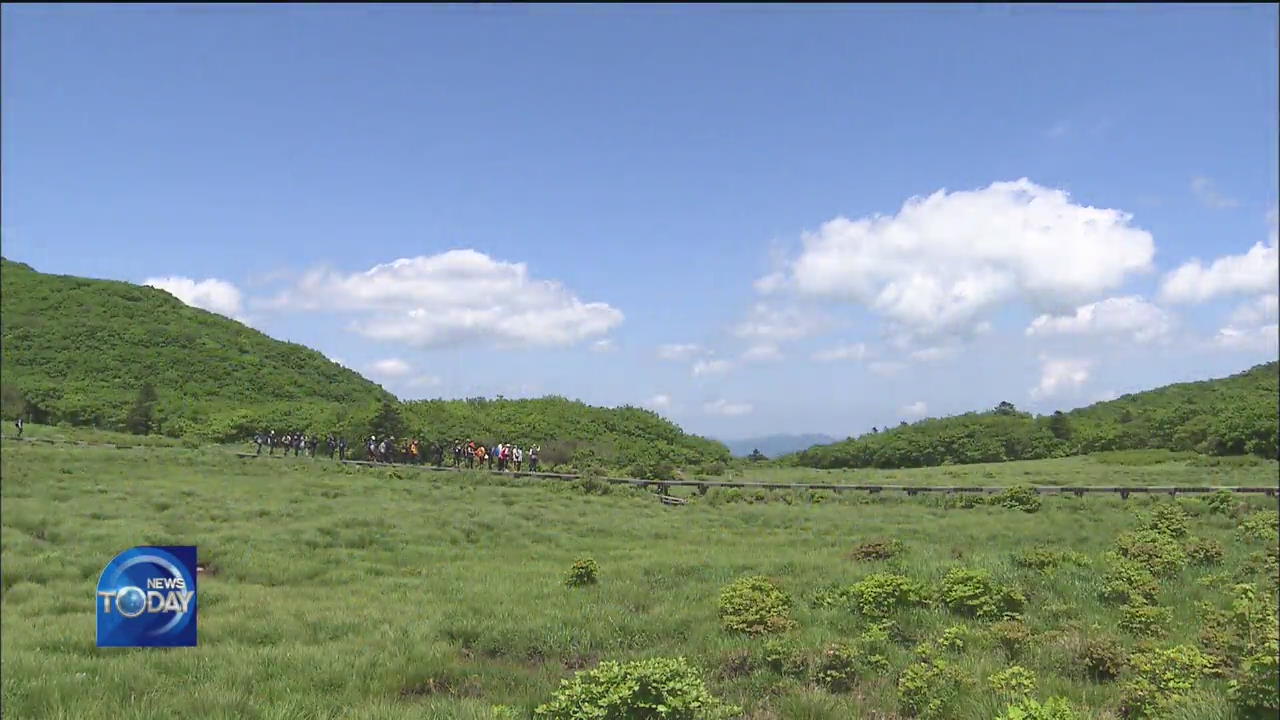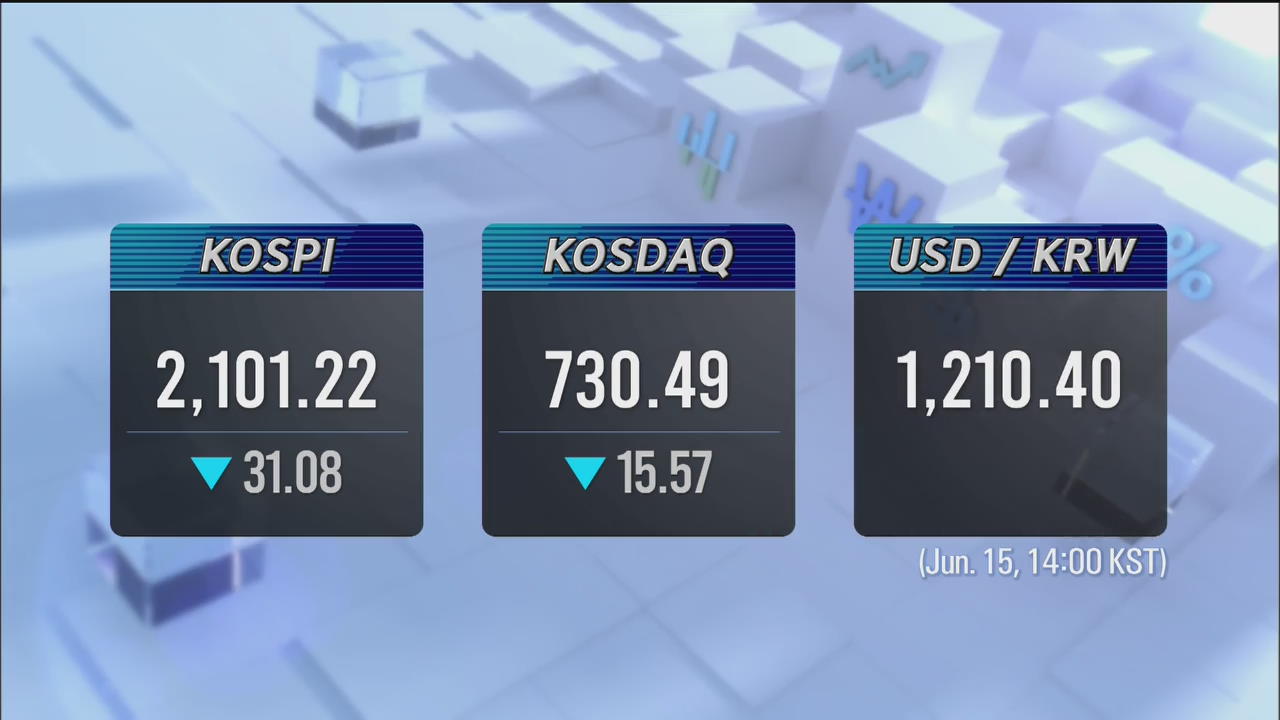YONGNEUP RISES AS NEW TOURIST HOTSPOT
입력 2020.06.15 (15:15)
수정 2020.06.15 (19:35)
읽어주기 기능은 크롬기반의
브라우저에서만 사용하실 수 있습니다.
[Anchor Lead]
Yongneup, or Dragon Swamp, the first wetland in Korea recognized by the Ramsar Convention, is located in Daeamsan Mountain, which stands between Inje and Yanggu in Gangwon-do Province. An increasing number of Koreans looking for some relief from the COVID-19 pandemic are visiting the globally-recognized high moor.
[Pkg]
At 1,200 meters above sea level, a vast green expanse stretches at the summit of Daeamsan Mountain. This is Yongneup, a swamp that never dries up. Round-leaved sundews wait for prey in silence. Plants that live only in wetlands are spotted all over the swamp. Visitors marvel in awe.
[Soundbite] JEONG IN-YEONG(VISITOR) : "I've never seen a high moor in Korea. Now that I've seen it in person, I can feel the vitality of nature."
What makes Yongneup so special can be found in the ground. The region's cool and humid climate led to the accumulation of partially decayed plants and eventual formation of thick layers of peat. The swamp contains the 4,500-year botanical history of the Korean Peninsula. This is why Yongneup is called the living natural history museum.
[Soundbite] KOH HYO-JIN(WONJU REGIONAL ENVIRONMENTAL AGENCY) : "The peat layers range from 1m to 1.8m in thickness. Even pine pollen was discovered intact at the bottom."
Visitors are allowed access to Yongneup for only five months in a year to preserve the area. The globally renowned swamp is expected to provide a spectacular sight as a variety of endangered wildflowers are to blossom in mid-July.
Yongneup, or Dragon Swamp, the first wetland in Korea recognized by the Ramsar Convention, is located in Daeamsan Mountain, which stands between Inje and Yanggu in Gangwon-do Province. An increasing number of Koreans looking for some relief from the COVID-19 pandemic are visiting the globally-recognized high moor.
[Pkg]
At 1,200 meters above sea level, a vast green expanse stretches at the summit of Daeamsan Mountain. This is Yongneup, a swamp that never dries up. Round-leaved sundews wait for prey in silence. Plants that live only in wetlands are spotted all over the swamp. Visitors marvel in awe.
[Soundbite] JEONG IN-YEONG(VISITOR) : "I've never seen a high moor in Korea. Now that I've seen it in person, I can feel the vitality of nature."
What makes Yongneup so special can be found in the ground. The region's cool and humid climate led to the accumulation of partially decayed plants and eventual formation of thick layers of peat. The swamp contains the 4,500-year botanical history of the Korean Peninsula. This is why Yongneup is called the living natural history museum.
[Soundbite] KOH HYO-JIN(WONJU REGIONAL ENVIRONMENTAL AGENCY) : "The peat layers range from 1m to 1.8m in thickness. Even pine pollen was discovered intact at the bottom."
Visitors are allowed access to Yongneup for only five months in a year to preserve the area. The globally renowned swamp is expected to provide a spectacular sight as a variety of endangered wildflowers are to blossom in mid-July.
■ 제보하기
▷ 카카오톡 : 'KBS제보' 검색, 채널 추가
▷ 전화 : 02-781-1234, 4444
▷ 이메일 : kbs1234@kbs.co.kr
▷ 유튜브, 네이버, 카카오에서도 KBS뉴스를 구독해주세요!
- YONGNEUP RISES AS NEW TOURIST HOTSPOT
-
- 입력 2020-06-15 15:15:48
- 수정2020-06-15 19:35:33

[Anchor Lead]
Yongneup, or Dragon Swamp, the first wetland in Korea recognized by the Ramsar Convention, is located in Daeamsan Mountain, which stands between Inje and Yanggu in Gangwon-do Province. An increasing number of Koreans looking for some relief from the COVID-19 pandemic are visiting the globally-recognized high moor.
[Pkg]
At 1,200 meters above sea level, a vast green expanse stretches at the summit of Daeamsan Mountain. This is Yongneup, a swamp that never dries up. Round-leaved sundews wait for prey in silence. Plants that live only in wetlands are spotted all over the swamp. Visitors marvel in awe.
[Soundbite] JEONG IN-YEONG(VISITOR) : "I've never seen a high moor in Korea. Now that I've seen it in person, I can feel the vitality of nature."
What makes Yongneup so special can be found in the ground. The region's cool and humid climate led to the accumulation of partially decayed plants and eventual formation of thick layers of peat. The swamp contains the 4,500-year botanical history of the Korean Peninsula. This is why Yongneup is called the living natural history museum.
[Soundbite] KOH HYO-JIN(WONJU REGIONAL ENVIRONMENTAL AGENCY) : "The peat layers range from 1m to 1.8m in thickness. Even pine pollen was discovered intact at the bottom."
Visitors are allowed access to Yongneup for only five months in a year to preserve the area. The globally renowned swamp is expected to provide a spectacular sight as a variety of endangered wildflowers are to blossom in mid-July.
Yongneup, or Dragon Swamp, the first wetland in Korea recognized by the Ramsar Convention, is located in Daeamsan Mountain, which stands between Inje and Yanggu in Gangwon-do Province. An increasing number of Koreans looking for some relief from the COVID-19 pandemic are visiting the globally-recognized high moor.
[Pkg]
At 1,200 meters above sea level, a vast green expanse stretches at the summit of Daeamsan Mountain. This is Yongneup, a swamp that never dries up. Round-leaved sundews wait for prey in silence. Plants that live only in wetlands are spotted all over the swamp. Visitors marvel in awe.
[Soundbite] JEONG IN-YEONG(VISITOR) : "I've never seen a high moor in Korea. Now that I've seen it in person, I can feel the vitality of nature."
What makes Yongneup so special can be found in the ground. The region's cool and humid climate led to the accumulation of partially decayed plants and eventual formation of thick layers of peat. The swamp contains the 4,500-year botanical history of the Korean Peninsula. This is why Yongneup is called the living natural history museum.
[Soundbite] KOH HYO-JIN(WONJU REGIONAL ENVIRONMENTAL AGENCY) : "The peat layers range from 1m to 1.8m in thickness. Even pine pollen was discovered intact at the bottom."
Visitors are allowed access to Yongneup for only five months in a year to preserve the area. The globally renowned swamp is expected to provide a spectacular sight as a variety of endangered wildflowers are to blossom in mid-July.
이 기사가 좋으셨다면
-
좋아요
0
-
응원해요
0
-
후속 원해요
0

















이 기사에 대한 의견을 남겨주세요.